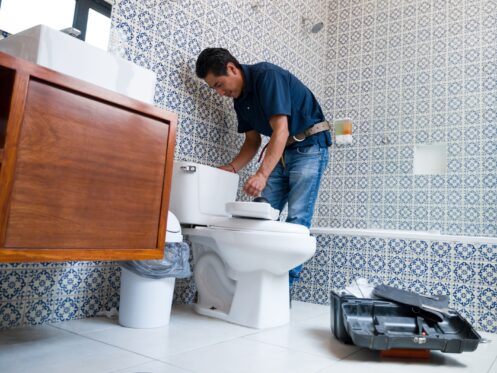Toilets aren’t built to last forever, even if they’ve been hanging in there for decades. Small signs like frequent clogs or hairline cracks can sneak up on you and turn into bigger problems when you least expect it. Instead of waiting for a full breakdown, it helps to recognize the red flags early.
At Cal’s Plumbing, in Tucson, AZ, we work with homeowners to determine when a repair is still viable and when it’s time to upgrade to something better. Check out these tips to know whether toilet repair or replacement makes the most sense.
Repeated Clogs That Never Fully Clear
A clog now and then can happen to everyone, but repeated backups often point to something deeper. The problem might not be with what’s going into the toilet, but with how the toilet pushes waste out. Older toilets lose flushing power over time. The siphon jet inside the bowl can get coated with minerals, which weakens the flow. Internal components like the flapper or fill valve may not reset properly after each flush, which means your next one starts with a half-full tank. You may even find yourself flushing twice just to keep things moving.
Visible Cracks Around the Base or Tank
Hairline cracks in porcelain don’t always look urgent at first. You might see a faint line along the base or a thin crack near the tank bolts and think it’s just cosmetic. But even a small split can turn into a leak with just a little pressure. Temperature shifts, tightening hardware, or settling floors can widen the crack and let water seep out. In bathrooms with tile or hardwood, even a slow drip adds up fast.
Outdated Flushing Technology
Toilets made before the mid-1990s often use much more water than needed. Older models can use up to 5 gallons per flush, while modern designs use closer to 1.6 gallons and do the job better. If your toilet predates the efficiency standards, you’re sending gallons of water down the drain with every use. That adds up quickly, especially in homes with multiple people. You might think upgrading your flapper or adjusting the float will save water, but you can’t change how the bowl and trap are shaped.
The flushing power in a newer model comes from smarter engineering, not just less water. If your water bill keeps climbing, or your toilet feels sluggish even after adjustments, it may be time to switch. Replacing your old toilet with a high-efficiency model gives you a faster, cleaner flush and can cut down your monthly water use without changing your habits.
Wobbling That Gets Worse With Time
A toilet that rocks when you sit down may seem like a minor annoyance, but that motion wears out more than your patience. The seal under the toilet, usually a wax ring, gets compressed and shifts every time the base moves. That leads to leaks that can go undetected until they cause significant damage. A loose toilet also stresses the flange that connects the unit to the drainpipe.
If the flange cracks or pulls away from the floor, you’re looking at more than a toilet replacement; you’ll need subfloor work, too. Some wobbling comes from uneven floors or missing shims, which can be fixed. But if you’ve already tried stabilizing it and the movement keeps coming back, the porcelain may be warped or the anchor bolts stripped. At that point, the better option is to replace the entire unit before water damage gets worse.
Constant Repairs or Fluctuating Performance
You’ve probably replaced a flapper here, adjusted a float there, maybe even swapped out the entire fill valve. These parts are meant to be replaced, but if you’re constantly fiddling with the tank or making the same fixes more than once a year, your toilet might be telling you it’s done. Frequent repairs often point to uneven wear inside the tank or worn-out materials that can’t maintain a proper seal. These symptoms mean water is leaking slowly into the bowl and triggering the refill valve. That constant cycle wastes water and signals internal wear that may not be worth chasing anymore.
Stains That Won’t Come Out
Toilets take a beating from hard water, minerals, and constant use. You might scrub and soak, use every cleaner in the cabinet, and still see the same brown or gray rings inside the bowl. These stains often come from minerals like iron or calcium that settle in areas where water flow is weak.
Over time, the porcelain becomes etched or roughened, which makes new buildup cling even faster. If the finish has worn down, it’s nearly impossible to get the bowl looking clean again, no matter how much elbow grease you use. And once that surface changes texture, the toilet becomes harder to clean and more likely to hold odors. If you’re tired of scrubbing and still think the toilet looks dirty, it might be time to replace it with a model that’s easier to clean and stays cleaner longer.
Tank Takes Forever to Refill
A slow refill doesn’t always mean something is broken, but it’s rarely a good sign. If you flush and then wait several minutes for the tank to fill, you’re dealing with a system that’s dragging its feet. The issue could be mineral buildup inside the supply valve or a worn-out fill valve inside the tank. It might even be the internal float sticking partway through the refill cycle.
In older toilets, these small delays pile up. You flush, the tank groans, the water drips slowly back in, and you’re left wondering if it’s ready to go again. If you’ve replaced the parts more than once and still see the same slow refill, it’s worth considering a new toilet. Newer units refill quickly and operate more quietly, which makes your bathroom more efficient and less frustrating to use.
Weak Flush That Leaves Waste Behind
A weak flush that leaves toilet paper or waste behind isn’t just annoying. It’s a sign that something inside the bowl or tank isn’t working the way it should. You might have a clog in the rim jets, which affects how water enters the bowl.
Or the siphon jet may be partially blocked, which cuts the power of the flush. In some cases, the problem lies with the trapway, especially if the internal shape doesn’t help waste move efficiently. While some of these problems can be cleaned or adjusted, others are part of the toilet’s original design. If your flush never feels strong enough, even after cleaning or repairs, the toilet may be underperforming by design. Swapping in a model with better flush ratings can make your bathroom easier to use without constant double flushing.
Strange Noises That Won’t Quit
Every toilet makes noise now and then, but if you hear loud squealing, humming, or high-pitched whining, your toilet might be on its last legs. These sounds often come from worn-out fill valves or parts that vibrate as water moves through them.
In older toilets, the materials used in those parts break down or lose flexibility, which leads to weird noises that echo through the house. You might hear them after flushing, during refills, or sometimes at random as the valve tries to hold pressure. If you’ve swapped out the fill valve more than once and the sound still returns, it could mean the tank design no longer works well with modern replacement parts. Some older toilets have dimensions or flow paths that don’t pair well with new components.
Replace Your Toilet Today
A well-functioning toilet shouldn’t be a daily hassle. If you’ve noticed signs of age or performance slipping, replacing it might be the cleanest solution. Along with toilet installation and other kinds of bathroom plumbing, Cal’s Plumbing can help with leak repairs, shutoff valve replacements, and fixture upgrades for a smoother bathroom experience. Book your toilet replacement with Cal’s Plumbing, and flush your plumbing problems for good.






